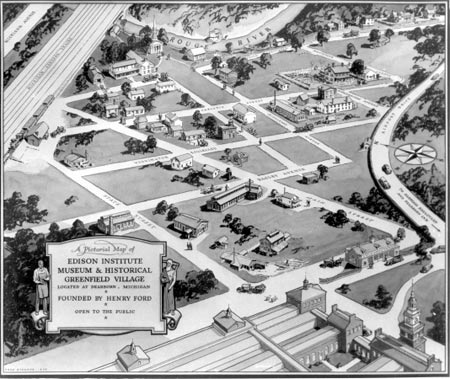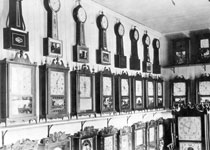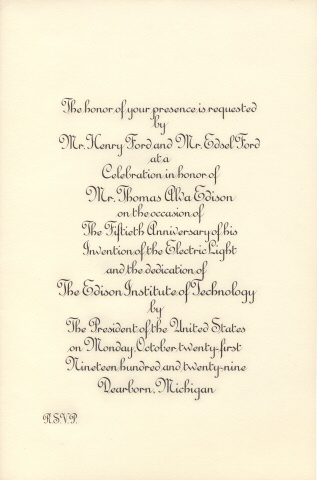Popular Research Topics
Origins of The Henry Ford
We are often asked about the origins of The Henry Ford. What was Henry Ford thinking when he built the museum and the village? Why did he build it? What did he hope to accomplish? These are very good questions which are hopefully addressed in the following explanation.
 |
| THF6579 (PA.8972) This map shows Greenfield Village as it looked when it officially opened to the public in June 1933. |
Although Henry Ford had developed from a farm boy with a mechanical bent into one of the world’s most powerful and wealthy industrialists, he and his wife, Clara, never forgot the values of the rural life they had left behind. As the inventor of the Model T and champion of the assembly line, Henry Ford was aware of the changes that the automobile and growing industrialization could and would bring to the way of life in rural America. Collecting the tangible evidence of America’s pre- and early industrial history eventually became Henry Ford’s passion. In the early 1900s he began accumulating items associated with his lifelong hero, Thomas Edison. He started storing a few miscellaneous items picked up through the years in a spare office at the Ford Motor Company’s Highland Park plant as early as 1906-07. By the 19teens, the clocks and watches he had loved tinkering with and repairing since childhood days had grown into a collection. He had also accumulated many other “artifacts” along with inventions and tools that he felt exemplified ordinary American’s day-to-day lives.
 |
 |
| THF9222 (P.833131081) Henry Ford tinkering with watch tools in Greenfield Village in the 1940s. |
THF9130 (P.189.1831.E) Clocks for
Mr. Ford’s Office, 1923. |
Then in 1916, the Chicago Tribune had printed a series of three articles based on interviews with Henry Ford, calling Ford ‘an anarchist’ and ‘an ignorant idealist’. Ford sued for libel for $1 million with the case coming to trial in Mt. Clemens, Michigan, in 1919. In one of the original articles, the Tribune quoted Ford as saying, ‘history is more or less bunk’. During the trial the defense attorneys, trying to prove Ford’s ‘ignorance,’ quizzed him on this statement. …Ford responded with, ‘I did not say it was bunk. It was bunk to me, but I did not say…’
What you could say is, Henry Ford never really believed that “history is bunk.” He believed that the kind of history taught in schools, the history that emphasized kings and generals—and omitted ordinary folks and the tools of everyday life—was useless. As he told his secretary, Ernest G. Liebold, on the way home from the trial:
“We’re going to start something. I’m going to start up a museum and give people a true picture of the development of the country. That’s the only history that is worth observing, that you can preserve in itself. We’re going to build a museum that’s going to show industrial history, and it won’t be bunk! We’ll show the people what actually existed in years gone by and we’ll show the actual development of American industry from the early days, from the earliest days that we can recollect up to the present day.”1
After ten more years of collecting, planning, and finally building this dream, The Edison Institute—the original name of Henry Ford Museum & Greenfield Village, which has grown to include the Benson Ford Research Center, Ford Rouge Factory Tour, and Imax Theater, and is now known collectively as The Henry Ford—opened on October 21, 1929. Henry Ford dedicated this institution to his friend Thomas Edison, and celebrated with a grand opening known as the Lights Golden Jubilee, in honor of the 50th anniversary of his invention of the electric light.
 |
| THF59068 (EI.52.5) Invitation to the Lights Golden Jubilee, Edison Institute Dedication. |
 |
| THF9156 (P.O.5826) Aerial view of the incomplete museum on the evening of the dedication, Oct. 21, 1929. |
Henry Ford created a remarkable collection that tells stories of ordinary people. Some of these people and their ideas changed our lives. Today, our collections both honor and build upon Henry Ford’s legacy.
Footnotes
- Accession 65, Oral Reminiscences of Ernest Liebold. Volume 11, p.890.
For more in-depth information about the origins of The Henry Ford please check-out the following books:
Bryan, Ford R., and edited by Sarah Evans.
Henry’s Attic: Some Fascinating Gifts to Henry Ford and His Museum. Dearborn, MI: Ford Books, 1995.
Miller, Jeanine Head,…[et al.], and Judith E. Endelman and Wendy Metros, editors.
Telling America’s Story: A History of The Henry Ford. Dearborn, MI: The Henry Ford; Virginia Beach, VA: Donning Co. Publishers, c2010.
Upward, Geoffrey C.
A Home for Our Heritage: the Building and Growth of Greenfield Village and Henry Ford Museum, 1929-1979. Dearborn, MI: Henry Ford Museum Press, [1979].
Watts, Steven.
The People’s Tycoon: Henry Ford and the American Century. New York: Alfred A. Knopf, 2005.